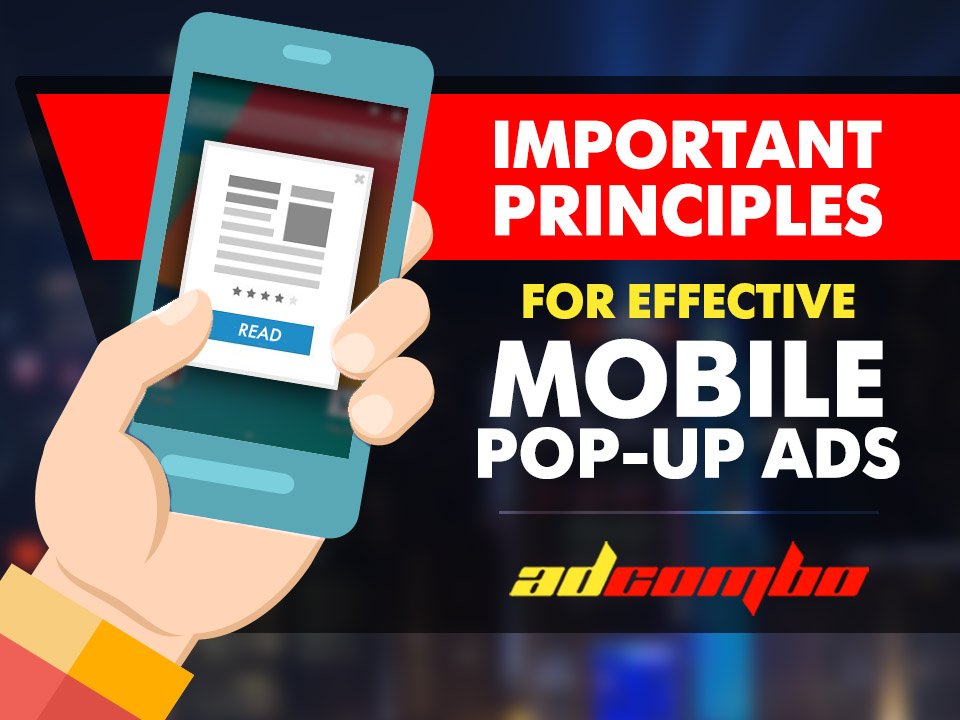-
 Important Principles for Effective Mobile Pop-Up Ads18.4.2017Reading Time: 4 minutes
Important Principles for Effective Mobile Pop-Up Ads18.4.2017Reading Time: 4 minutesAs you already know, advertising and promotion on the Internet can take on a myriad of different formats and some of these may be more effective than others under different circumstances. For a great number of years, pop-up ads worked remarkably well for many industries, especially as the prevalence of so-called “ad blindness” continued to rise. It became easier to ignore traditional banner ads, but pop-ups (and pop-unders) are far more difficult for users to ignore and this meant that publishers and advertisers could see better engagement rates.
And as mobile use continues to rise, even surpassing traditional desktop and laptop use by some measures, it only makes sense that Google wants to prioritize the mobile experience. Websites with responsive or mobile-friendly designs are given preferential treatment in the search engine rankings. When Google announced that it would be cracking down on mobile pop-ups, Internet marketers from clear across the globe let out a collective gasp.
What would this mean for their marketing efforts? Does this mean that the age of the mobile pop-up ad is already dead?
The short answer is no. It just means you need to approach the ad format in a slightly different way.
Keep in mind here that Google’s objective is to provide the best possible user experience. As a result, the main types of mobile ads that it is starting to penalize are ones that make for a poorer user experience. If a pop-up is intrusive, particularly as a standalone interstitial or one that blocks the main content as soon as the user arrives on the webpage, that’s not good in Google’s eyes. This is just one of the signals Google will use for SEO purposes, and if you are strong in other areas it may overlook it, but this is still something to keep in mind.
Given this, what are some general guidelines and tips you should be following if you wish to continue using mobile pop-ups as part of your overall marketing mix?
1. Use pop-up banner ads that do not occupy the entirety of the screen on a mobile device. This is perhaps the most important tip in the context of mobile ads. There is no hard and fast rule here, but Google has indicated that if a banner “uses a reasonable amount of screen space,” the website and webpage will not be penalized. A good example of this would be an ad that pops up to occupy the top quarter or the bottom quarter of the screen. This still allows the main content of the webpage to be easily visible and scrolled through, all while providing good visibility to the ad too.
2. Never use mobile pop-up ads upon page load. Pop-up ads can be triggered by a number of different types of events and one of the most common used to be upon page load. As soon as the user arrives on the site, the pop-up appears. This is now highly discouraged, both from a user experience standpoint and in the eyes of Google’s algorithm. Indeed, over two-thirds of users are much more inclined to simply leave the site if they find that it has too many ads.
Instead, have the pop-up load either after some period of time has passed (at least 30 seconds) indicating that the user is indeed interested in the content you have or have it load after the user has scrolled through at least half the article, also indicating an elevated level of interest and engagement. Better still, implement the ad such that it only loads when the user has reached the end of a blog post, for example. The user is very interested in your material and likely is interested in more. Hit them when they are at their most receptive.
3. Utilize the pop-up ad as an intermediary. The initial inclination for many affiliates is to use a pop-up ad to promote an affiliate offer directly. Perhaps a more fruitful strategy is to use the pop-up ad to promote an internal offering first. This could be to encourage a visitor to subscribe to your email list or to download premium content, like an ebook. Then, inside the email newsletter or premium content, you can promote one or more affiliate products. Pop-ups are very effective for increasing email subscriptions, boosting the opt-in rate for Entrepreneur.com by 86 percent and even converting up to 1375% better than static forms, according to an experiment by Aweber. This has the added advantage of keeping the user within your sales funnel, making it easier for you to promote additional offers over the long-term.
4. Never use pop-up ads to promote purchase links. While the click-thru rate on mobile pop-up ads can be quite good, the actual conversion rate can be more of a challenge. This is especially true in the context of e-commerce where conversion rates are among the lowest. Users are far less likely to complete an “add-to-cart” type click from a pop-up on a smartphone. This relates back to tip #3 above. Use the pop-up to pull the user deeper down your sales funnel and complete the conversion in the next step instead, whether that’s through premium content or an email subscription.
5. Advertise in mobile apps instead. A big part of the whole concern over the state of mobile pop-up ads has to do with Google search engine rankings. It does not affect advertising in mobile apps, since they are not at the mercy of the same algorithm. Whether you are monetizing your own app or you are buying advertising through a marketplace (or directly through an app publisher), the latter of which can provide remarkably cheap CPMs and CPCs, full page interstitial pop-ups are still very much the norm here.
Again, it is likely in your best interest to avoid a direct “add-to-cart” type ecommerce link for your mobile pop-up inside of an app. Use the interstitial to promote a sale on your mobile e-commerce site, your own mobile app, or some other possible intermediary. Some of the bigger mobile ad networks in this space include AdMob, mMedia, Adfonic, and Tapjoy. Some ads are designed to reward users with virtual currency in exchange for an action, which could be perfect for pay-per-install type CPA offers, for example.
Advertising will always continue to evolve on the Internet. Adapting to the smaller screen of a mobile device and keeping up with changes to Google’s algorithms are only one part of the equation, but you don’t want to shoot yourself in the foot by starting at a disadvantage either. Avoid full-screen, intrusive pop-ups, especially for mobile traffic, and always keep the end user experience in mind.





Thanks for the highly informative post. As a newbie to SEO and mobile app world I constantly try to educate myself and your article was definitely helpful. thanks a ton. cheers